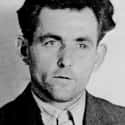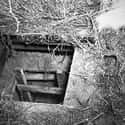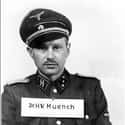-
(#7) The Amazing And Mostly Forgotten Georg Elser
In November 1939, German carpenter Georg Elser set out for Munich. He was alarmed by what was happening in Germany and wanted to assassinate Hitler before the dictator dragged the country into another costly war. Elser knew Hitler frequently changed his itinerary at the last minute as a security measure, but the one event he never failed to attend was the anniversary celebration of the 1923 Beer Hall Putsch, the first attempt by the Nazis to seize power. Hitler spoke annually at the site where the putsch began, the Burgerbraukeller beer hall.
When Elser checked out the hall, he noticed a pillar supporting a balcony over the speaker's dais, the perfect spot to plant a bomb. After 30 straight nights of chiseling the pillar, Elser hollowed out a place for his intricately designed, timed explosive device, which was set to detonate right in the middle of Hitler's traditional 90-minute speech. Elser was so methodical, he lined the hole with cork to muffle the ticking clock of the bomb and put tin around it so any attempt to nail decorations through his device would be repelled.
Everything was in place three days before Hitler's November 8 speech. Unfortunately, Hitler was planning to attack France on November 12, 1939. Although he eventually postponed the invasion until spring 1940, Hitler wanted to quickly return to Berlin to oversee the operation. He cut his speech to an hour so he could catch a train back to Berlin. Just 12 minutes after Hitler left, Elser's bomb went off, killing seven people and injuring 63. The carpenter was on his way to the Swiss border, having scouted a route through the frontier months ago.
But Elser hadn't counted on wartime security and was detained as he approached the border. He was arrested and tortured before being placed in the Dachau concentration camp. Hitler was convinced the Allies were behind Elser's conspiracy, and the carpenter was kept alive in the hopes of eventually staging a show trial. However, the imminent end of the war forced Hitler's hand. Elser was secretly executed at Dachau in April 1945. The exact date is debated.
-
(#2) The Art Forger And The Reichsmarschall
In May 1945, in the Netherlands, an art dealer named Han Van Meegeren was arrested and charged with selling a Vermeer painting to Hermann Goering, a leading member of the Nazi party. This form of collaboration carried a capital sentence, and Van Meegeren was wise to confess to a lesser but no less remarkable crime: He claimed the work in question was a forgery, and that he had forged it and other Vermeers that art appraisers had deemed genuine.
Before WWII, Van Meegeren, an aspiring artist who disliked modern art and was frustrated by being ignored, began forging paintings to mock the art establishment. After his first forgery was declared a genuine Vermeer and sold for millions, Van Meegeren created more. By 1943, he earned the equivalent of $60 million. One of his paintings was sold to Hermann Goering via a dealer, who implicated Van Meegeren after the work was recovered with other Nazi art.
The court dismissed the collaboration charge, convicted him of forgery, and sentenced him to a year in jail. While Van Meegeren's attorneys appealed, the forger perished of a heart attack in December 1947.
-
(#5) The D-Day Medic Heroes Of Angoville-au-Plain
In the early hours of June 6, 1944, thousands of allied paratroopers were dropped behind enemy lines in anticipation of the invasion of Normandy. One of the main objectives of the 101st Airborne was to capture the small village of Angoville-au-Plain. When intense fighting broke out over the village, two American medics, Robert Wright and Kenneth Moore, set up a medical station in the tiny town church.
US paratroopers established control of Angoville-au-Plain, but German units quickly counterattacked and forced American troops back. Wright and Moore stayed behind, and when German soldiers entered the church, they were hostile to the Americans until they realized the medics were treating their wounded, as well. They left, posting a Red Cross flag at the entrance. For three days, the fighting raged on and the village changed hands several times, but the two medics toiled away, saving 80 lives, including a local teenager.
Today, all of the stained glass windows in the church (the originals were destroyed in the battle) are tributes to Wright, Moore, and the 101st Airborne. Wright visited the church in 2004, and some of his ashes were spread in Angoville-au-Plain's cemetery.
-
(#14) The Not-So-Great Escape
Allied POW escapes in Europe have been the stuff of legend since WWII ended. But 400,000 Germans prisoners were housed across the US during WWII. On December 23, 1944, 25 of these men attempted to escape from a Papago Park, Arizona, prison camp. The POWs were all U-boat officers or crew and were determined to get to Mexico, then home to Germany. In preparation, they sold fake German medals to guards to obtain cash, created phony IDs, and three men even created a raft they hoped to sail down the nearby Gila River.
By December, a tunnel was successfully built to get the Germans out of the compound. Late on Friday the 23rd, while many of the other 3,000 prisoners acted as though nothing was going in, the 25 men, in small groups, made their way out through the tunnel.
The FBI and Native-American scouts were mobilized. By then, some of the Germans, stranded in cold, rainy weather, turned themselves in. The rafters got to the Gila, but it was essentially an elongated mud puddle, rendering the raft useless. They were captured near the riverbank. Within a month, the last prisoner was arrested by police in downtown Phoenix at a railway station.
-
(#13) The Sinking of the Cap Arcona, Worse Than the Titanic
In 1927, the German Hamburg South-America Line launched Cap Arcona, a passenger ship meant to to rival the size and luxury of the Titanic. It was the largest, fastest ocean liner between Europe and South America. With the onset of WWII, Cap Arcona was conscripted into a naval HQ. Briefly involved in a dramatic film orchestrated by Josef Goebbels, the ship sat rusting in the Baltic until the final days of WWII.
Negotiations took place between Heinrich Himmler and Count Bernadotte of Sweden to use Cap Arcona and other, smaller craft to transport Scandinavian concentration camp prisoners to safety in Sweden in 1945. The British, believing Cap Arcona would be used by escaping military SS, attacked the ship, as well as other craft in its vicinity, not knowing German prisoners were still onboard. The bombing killed all but 50 of the 2,800 people aboard. This friendly fire incident remains one of the worst disasters in maritime history.
-
(#10) Hans Munch, 'The Good Man Of Auschwitz'
The conduct of Nazi staff at Auschwitz is an appalling chapter in human history. The cruelty routinely perpetrated was so egregious that, in 1947, a Polish court convened a special tribunal to mete out justice to 40 former Auschwitz personnel. Of the defendants, only Dr. Hans Munch was acquitted.
Former prisoners testified that Munch had been kind and humane; he gave them food and extended bogus experiments on female prisoners because he knew they would be gassed once the experiments were concluded. Most impressive, Munch refused to participate in the selection process dictating who lived or perished at Auschwitz. In the final days of WWII, his last official act at a concentration camp was to advise an inmate on how to escape, wish him good luck, and hand him his service revolver.
New Random Displays Display All By Ranking
About This Tool
World War II is a disaster that mankind cannot forget. Almost everyone who has learned human history will more or less know some important historical events during World War II. World War II was one of the cruelest wars in human history, thousands of people died in this war. There are many amazing stories that happened in this special period, some of which are familiar and others are little known.
Over the decades, as mankind’s self-reflection on wars and exploration of history, some new stories during World War II have begun to emerge. The random tool shares 14 little-known stories from World War II that you can not know from history books.
Our data comes from Ranker, If you want to participate in the ranking of items displayed on this page, please click here.
















